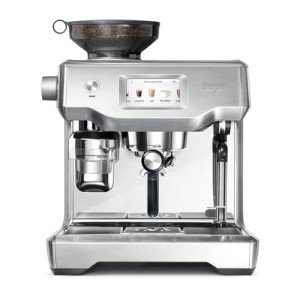The Advanced Guide To Heat Exchange Espresso Machines

Heat Exchange Espresso Machines: A Comprehensive Guide
Espresso machines have actually progressed significantly over the years, catering to the needs of home baristas and coffee specialists alike. Amongst these machines, heat exchange espresso machines have actually gotten appeal due to their ability to deliver constant performance and remarkable brew quality. In this short article, we will explore the functions, benefits, and crucial functions of heat exchange espresso machines, offering an extensive understanding for both potential purchasers and coffee lovers.
Comprehending Heat Exchange Technology
Heat exchange espresso machines operate on a special principle that allows simultaneous water heating for brewing and steaming. They are geared up with a single boiler that makes use of a heat exchanger system. This feature is substantial as it makes it possible for users to brew espresso while steaming milk concurrently, promoting efficiency in the coffee-making process.
How Does a Heat Exchange Espresso Machine Work?
The process begins with the machine's water inlet filling the boiler. As the water warms up, it turns to steam. The ingenious heat exchanger uses hot steam to heat additional water in a different passage developed specifically for the brew group. This suggests that water can reach the ideal brewing temperature level without waiting for the boiler to change. The essential steps consist of:
- Water Fill: Water is drawn into the boiler.
- Heating Process: The boiler warms up as water is transformed into steam.
- Heat Exchange: Steam heats water in the heat exchanger tube.
- Developing: Water from the heat exchanger is pressed through coffee grounds, extracting the tastes needed for a rich espresso.
This procedure permits quick temperature level modifications and improved coffee extraction.
Benefits of Heat Exchange Espresso Machines
Heat exchange espresso machines use a number of benefits, particularly for those wanting to optimize their coffee experience. Here are some crucial advantages:
- Simultaneous Brewing and Steaming: Users can brew espresso while steaming milk, making it ideal for hectic cafes and home baristas who value performance.
- Temperature Stability: The boiler's steam pressure helps preserve a steady temperature, which is crucial for constant espresso extraction.
- Flexibility: The design enables fast changing between brewing and steaming, making it much easier to create various coffee beverages, from lattes to coffees.
- User-friendly: Models often come with accessible controls, making it practical for both novices and knowledgeable baristas to produce quality drinks.
- Professional Quality: Heat exchange machines are typically utilized in commercial settings, providing users with high-quality developing performance at home.
Key Features to Look for in Heat Exchange Espresso Machines
When thinking about the purchase of a heat exchange espresso machine, there are a number of functions that one should take into account:
- Build Quality: Look for machines made from resilient products, such as stainless steel or brass, guaranteeing longevity.
- Boiler Size: A larger boiler will hold more water and sustain greater output in time.
- PID Temperature Control: This feature helps maintain consistent brew temperatures, which can enhance the coffee-making process.
- Group Head Design: Machines with a saturated or semi-saturated group head provide much better temperature stability.
- Relieve of Use: User-friendly user interfaces and user-friendly controls boost the general experience for baristas at all skill levels.
- Steam Wand Quality: An excellent steam wand with correct insulation and versatility permits better texturing of milk.
- Water Reservoir Size: Depending on your needs, think about how typically you want to refill the water reservoir.
Contrast of Popular Heat Exchange Espresso Machines
To better comprehend the options readily available in the market, listed below is a contrast table of some popular heat exchange espresso machines:
| Machine Model | Boiler Size | PID Control | Price Range | User Ratings |
|---|---|---|---|---|
| Profitec Pro 700 | 2.0 L | Yes | ₤ 2,000-₤ 2,500 | 9.5/ 10 |
| Rocket Espresso R58 | 1.8 L | Yes | ₤ 2,400-₤ 2,800 | 9.4/ 10 |
| Elekta Bianca | 1.8 L | Yes | ₤ 2,500-₤ 3,000 | 9.6/ 10 |
| La Spaziale S1 Vivaldi II | 1.5 L | Yes | ₤ 1,800-₤ 2,200 | 9.2/ 10 |
| Bezzera Magica | 1.2 L | No | ₤ 1,600-₤ 1,800 | 9.0/ 10 |
Frequently Asked Questions About Heat Exchange Espresso Machines
What is the main difference in between a heat exchange and a dual boiler espresso machine?
While both types can brew espresso and steam milk at the very same time, dual boiler machines have different boilers for developing and steaming. On the other hand, heat exchange machines use a single boiler and a heat exchanger to attain the exact same function.
Are heat exchange machines ideal for novices?
Yes! Numerous heat exchange machines are developed with easy to use functions, making them accessible for beginners. With proper assistance and practice, users can rapidly produce quality espresso.
What kind of maintenance do heat exchange espresso machines need?
Routine maintenance includes descaling, cleaning up the boiler, examining seals and gaskets, and keeping the group head tidy. Regular upkeep ensures longevity and consistent efficiency.
Can I use a heat exchange machine for different kinds of coffee beverages?
Absolutely! Heat exchange machines allow users to create a range of coffee beverages, consisting of espresso, lattes, coffees, and more.
Heat exchange espresso machines represent a blend of innovation and custom, offering coffee enthusiasts with the tools needed for crafting the perfect cup. Their ability to at the same time brew and steam, combined with precise temperature level control, makes them an engaging choice for both home baristas and experts. With Steam Espresso Machines on features and maintenance, users can open a world of charming coffee experiences, ensuring that each sip is as wonderful as the last.

